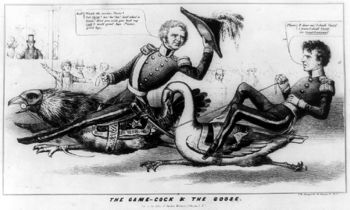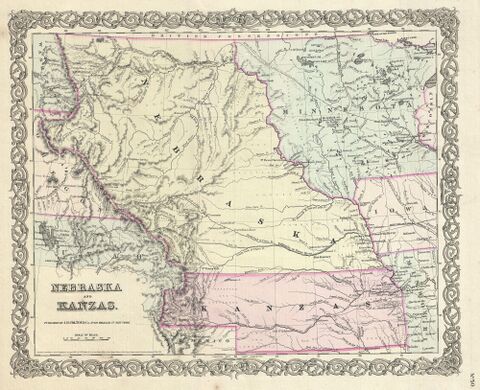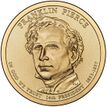فرانكلين پيرس
فرانكلين پيرس | |
|---|---|
Franklin Pierce | |
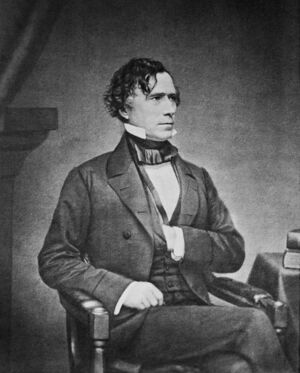 پورتريه بريشة ماثيو بريدي، ح. 1855–1865 | |
| 14 رئيس الولايات المتحدة | |
| في المنصب 4 مارس 1853 – 4 مارس 1857 | |
| نائب الرئيس |
|
| سبقه | ميلارد فيلمور |
| خلـَفه | جيمس بيوكانن |
| سناتور الولايات المتحدة عن نيوهامپشر | |
| في المنصب 4 مارس 1837 – 28 فبراير 1842 | |
| سبقه | جون پيدج |
| خلـَفه | ليونارد ويلكوكس |
| عضو of the U.S. مجلس النواب عن نيوهامپشر's at-large district | |
| في المنصب 4 مارس 1833 – 3 مارس 1837 | |
| سبقه | جوسف هامونز |
| خلـَفه | جارد وليامز |
| الناطق باسم New Hampshire House of Representatives | |
| في المنصب 5 يناير 1831 – 2 يناير 1833 | |
| سبقه | Samuel C. Webster |
| خلـَفه | تشارلز آثرتون |
| عضو New Hampshire House of Representatives from هيلزبورو | |
| في المنصب 7 يناير 1829 – 2 يناير 1833 | |
| سبقه | توماس ولسون |
| خلـَفه | هايرام مونرو |
| تفاصيل شخصية | |
| وُلِد | نوفمبر 23, 1804 هيلزبورو، نيوهامپشر، الولايات المتحدة |
| توفي | أكتوبر 8, 1869 (aged 64) كونكورد، نيوهامپشر، U.S. |
| المثوى | Old North Cemetery كونكورد، نيوهامپشر، الولايات المتحدة |
| الحزب | الديمقراطي |
| الزوج | Jane Appleton (ز. خطأ: زمن غير صحيح.; و. خطأ: زمن غير صحيح.) |
| الأنجال | 3 |
| الأب | بنجامن پيرس |
| الأقارب | بنجامن كندريك پيرس (شقيق) |
| التعليم | |
| المهنة |
|
| التوقيع | |
| الخدمة العسكرية | |
| الفرع/الخدمة | |
| سنوات الخدمة |
|
| الرتبة |
|
| المعارك/الحروب | |
فرانكلن پيرس Franklin Pierce (23 نوفمبر 1804 - 8 أكتوبر 1869)، الرئيس الرابع عشر للولايات المتحدة وذلك بين عامي 1853 - 1857. استفحلت في عهده مشكلة الإسترقاق. He was a northern Democrat who believed that the abolitionist movement was a fundamental threat to the nation's unity. He alienated anti-slavery groups by signing the Kansas–Nebraska Act and enforcing the Fugitive Slave Act. Conflict between North and South continued after Pierce's presidency, and, after Abraham Lincoln was elected president in 1860, Southern states seceded, resulting in the American Civil War.
Pierce was born in New Hampshire. He served in the U.S. House of Representatives from 1833 until his election to the Senate, where he served from 1837 until his resignation in 1842. His private law practice was a success, and he was appointed New Hampshire's U.S. Attorney in 1845. He took part in the Mexican–American War as a brigadier general in the Army. Democrats saw him as a compromise candidate uniting Northern and Southern interests, and nominated him for president on the 49th ballot at the 1852 Democratic National Convention. He and running mate William R. King easily defeated the Whig Party ticket of Winfield Scott and William A. Graham in the 1852 presidential election.
As president, Pierce attempted to enforce neutral standards for civil service while also satisfying the Democratic Party's diverse elements with patronage, an effort that largely failed and turned many in his party against him. He was a Young America expansionist who signed the Gadsden Purchase of land from Mexico and led a failed attempt to acquire Cuba from Spain. He signed trade treaties with Britain and Japan and his Cabinet reformed its departments and improved accountability, but political strife during his presidency overshadowed these successes. His popularity declined sharply in the Northern states after he supported the Kansas–Nebraska Act, which nullified the Missouri Compromise, while many Southern whites continued to support him. The act's passage led to violent conflict over expanding slavery in the American West. Pierce's administration was further damaged when several of his diplomats issued the Ostend Manifesto calling for the annexation of Cuba, a document that was roundly criticized. He fully expected the Democrats to renominate him in the 1856 presidential election, but they abandoned him and his bid failed. His reputation in the North suffered further during the American Civil War as he became a vocal critic of President Abraham Lincoln.
Pierce was popular and outgoing, but his family life was difficult; his three children died young and his wife, Jane Pierce, suffered from illness and depression for much of her life.[1] Their last surviving son was killed in a train accident while the family was traveling, shortly before Pierce's inauguration. A heavy drinker for much of his life, Pierce died in 1869 of cirrhosis of the liver. Historians and scholars generally rank Pierce as one of the worst and least memorable U.S. presidents.
. . . . . . . . . . . . . . . . . . . . . . . . . . . . . . . . . . . . . . . . . . . . . . . . . . . . . . . . . . . . . . . . . . . . . . . . . . . . . . . . . . . . . . . . . . . . . . . . . . . . . . . . . . . . . . . . . . . . . . . . . . . . . . . . . . . . . . . . . . . . . . . . . . . . . . . . . . . . . . . . . . . . . . . .
النشأة والعائلة
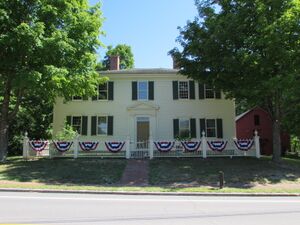 The Franklin Pierce Homestead in Hillsborough, New Hampshire, where Pierce grew up, is now a National Historic Landmark.[2] He was born in a nearby log cabin as the homestead was being completed.[note 2] |
الطفولة والتعليم
ولد في نيوهامپشر، ودرس في أكاديمية فيليپس إكستر الداخلية الراقية.
الحرب المكسيكية الأمريكية
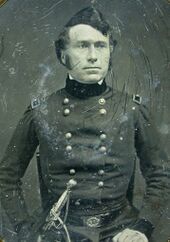
تطوع في الجيش الأمريكي أثناء الحرب المكسيكية الأمريكية، وسرعان ما ترقى إلى كولونل. وفي مارس 1847 أصبح بريگادير جنرال للمتطوعين وقاد لواء التعزيزات لجيش وينفيلد سكوت الزاحف على مكسيكو سيتي.
انتخابات 1852
 مقالة مفصلة: الانتخابات الرئاسية الأمريكية، 1852
مقالة مفصلة: الانتخابات الرئاسية الأمريكية، 1852
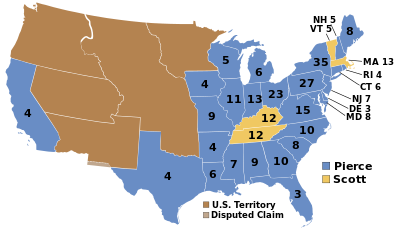
الرئاسة 1853-1857
السياسة الاقتصادية والتحسينات الداخلية
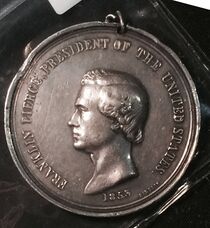
Pierce charged Treasury Secretary James Guthrie with reforming the Treasury, which was inefficiently managed and had many unsettled accounts. Guthrie increased oversight of Treasury employees and tariff collectors, many of whom were withholding money from the government. Despite laws requiring funds to be held in the Treasury, large deposits remained in private banks under the Whig administrations. Guthrie reclaimed these funds and sought to prosecute corrupt officials, with mixed success.[5]
Secretary of War Jefferson Davis, at Pierce's request, led surveys by the Corps of Topographical Engineers of possible transcontinental railroad routes throughout the country. The Democratic Party had long rejected federal appropriations for internal improvements, but Davis felt that such a project could be justified as a Constitutional national security objective. Davis also deployed the Army Corps of Engineers to supervise construction projects in the District of Columbia, including the expansion of the United States Capitol and building of the Washington Monument.[6]
الشئون الخارجية والعسكرية
The Pierce administration aligned with the expansionist Young America movement, with Marcy leading the charge as Secretary of State. Marcy sought to present to the world a distinctively American, republican image. He issued a circular recommending that U.S. diplomats wear "the simple dress of an American citizen" instead of the elaborate diplomatic uniforms worn in the courts of Europe, and that they only hire American citizens to work in consulates.[7][8] Marcy received international praise for his 73-page letter defending Austrian refugee Martin Koszta, who had been captured abroad in mid-1853 by the Austrian government despite his intention to become a U.S. citizen.[9][10]
تمت في عهده صفقة شراء گادسدن وهي مساحات شاسعة من الأراضي تم شراءها من المكسيك وتشكل جزءاً كبيراً من ولايتي أريزونا ونيومكسيكو.
Davis, an advocate of a southern transcontinental route, persuaded Pierce to send rail magnate James Gadsden to Mexico to buy land for a potential railroad. Gadsden was also charged with re-negotiating the provisions of the Treaty of Guadalupe Hidalgo which required the U.S. to prevent Native American raids into Mexico from New Mexico Territory. Gadsden negotiated a treaty with Mexican President Antonio López de Santa Anna in December 1853, purchasing a large swath of land to America's southwest. Negotiations were nearly derailed by William Walker's unauthorized expedition into Mexico, and so a clause was included charging the U.S. with combating future such attempts.[11][12] Congress reduced the Gadsden Purchase to the region now comprising southern Arizona and part of southern New Mexico; the price was cut from $15 million to $10 million. Congress also included a protection clause for a private citizen, Albert G. Sloo, whose interests were threatened by the purchase. Pierce opposed the use of the federal government to prop up private industry and did not endorse the final version of the treaty, which was ratified nonetheless.[13][12] The acquisition brought the contiguous United States to its present-day boundaries, excepting later minor adjustments.[14]
| حكومة پيرس | ||
|---|---|---|
| المنصب | الاسم | الفترة |
| الرئيس | فرانكلن پيرس | 1853 – 1857 |
| نائب الرئيس | وليام ر. كنگ | 1853 |
| لا أحد | 1853 – 1857 | |
| وزير الخارجية | وليام مارسي | 1853 – 1857 |
| وزير الخزانة | جيمس گثري | 1853 – 1857 |
| وزير الحربية | جفرسون ديڤس | 1853 – 1857 |
| المدعي العام | كالب كوشنگ | 1853 – 1857 |
| المدير العام لمصلحة البريد | جيمس كامبل | 1853 – 1857 |
| وزير البحرية | جيمس دبن | 1853 – 1857 |
| وزير الداخلية | روبرت مكللند | 1853 – 1857 |
Relations with Great Britain needed resolution, as American fishermen were upset at the British Royal Navy's increasing enforcement of Canadian territorial waters. Marcy completed a trade reciprocity agreement with British minister to Washington, John Crampton, which reduced the need for British coastline enforcement. Buchanan was sent as minister to London to pressure the British government, which was slow to support a new treaty. A favorable reciprocity treaty was ratified in August 1854, which Pierce saw as a first step towards the American annexation of Canada.[15][16] While the administration negotiated with Britain over the Canada–U.S. border, U.S. interests were also an issue in Central America, where the Clayton–Bulwer Treaty of 1850 had failed to keep Great Britain from expanding its influence in the region. Gaining the advantage over Britain in the region was a key part of Pierce's expansionist goals.[17][18]
British consuls in the United States sought to enlist Americans for the Crimean War in 1854, in violation of neutrality laws, and Pierce eventually expelled minister Crampton and three consuls. To the President's surprise, the British did not expel Buchanan in retaliation. In his December 1855 State of the Union message to Congress, Pierce had set forth the American case that Britain had violated the Clayton-Bulwer Treaty. The British, according to Buchanan, were impressed by the message and were rethinking their policy. Nevertheless, Buchanan was not successful in getting the British to abandon their Central American possessions. The Canadian treaty was ratified by Congress, the British parliament, and by the colonial legislatures in Canada.[19]
Pierce's administration aroused sectional apprehensions when three U.S. diplomats in Europe drafted a proposal to the president to purchase Cuba from Spain for $120 million (USD), and justify the "wresting" of it from Spain if the offer were refused. The publication of the Ostend Manifesto, which had been drawn up at the insistence of Secretary of State Marcy, provoked the scorn of northerners who viewed it as an attempt to annex a slave-holding possession to bolster Southern interests. It helped discredit the expansionist policy of Manifest Destiny the Democratic Party had often supported.[20][21]
Pierce favored expansion and a substantial reorganization of the military. Secretary of War Davis and Navy Secretary James C. Dobbin found the Army and Navy in poor condition, with insufficient forces, a reluctance to adopt new technology, and inefficient management.[22] Under the Pierce administration, Commodore Matthew C. Perry visited Japan (a venture originally planned under Fillmore) in an effort to expand trade to the East. Perry wanted to encroach on Asia by force, but Pierce and Dobbin pushed him to remain diplomatic. Perry signed a modest trade treaty with the Japanese shogunate which was successfully ratified.[23][24] The 1856 launch of the USS Merrimac, one of six newly commissioned steam frigates, was one of Pierce's "most personally satisfying" days in office.[25]
. . . . . . . . . . . . . . . . . . . . . . . . . . . . . . . . . . . . . . . . . . . . . . . . . . . . . . . . . . . . . . . . . . . . . . . . . . . . . . . . . . . . . . . . . . . . . . . . . . . . . . . . . . . . . . . . . . . . . . . . . . . . . . . . . . . . . . . . . . . . . . . . . . . . . . . . . . . . . . . . . . . . . . . .
كانزس النازفة
The greatest challenge to the country's equilibrium during the Pierce administration was the passage of the Kansas–Nebraska Act. Organizing the largely unsettled Nebraska Territory, which stretched from Missouri to the Rocky Mountains, and from Texas north to what is now the Canada–U.S. border, was a crucial part of Douglas's plans for western expansion. He wanted a transcontinental railroad with a link from Chicago to California, through the vast western territory. Organizing the territory was necessary for settlement as the land would not be surveyed nor put up for sale until a territorial government was authorized. Those from slave states had never been content with western limits on slavery, and felt it should be able to expand into territories procured with blood and treasure that had come, in part, from the South. Douglas and his allies planned to organize the territory and let local settlers decide whether to allow slavery. This would repeal the Missouri Compromise of 1820, as most of it was north of the 36°30′ N line the Missouri Compromise deemed "free". The territory would be split into a northern part, Nebraska, and a southern part, Kansas, and the expectation was that Kansas would allow slavery and Nebraska would not.[26][27][28] In the view of pro-slavery Southern politicians, the Compromise of 1850 had already annulled the Missouri Compromise by admitting the state of California, including territory south of the compromise line, as a free state.[29]
Pierce had wanted to organize the Nebraska Territory without explicitly addressing the matter of slavery, but Douglas could not get enough Southern votes to accomplish this.[30] Pierce was skeptical of the bill, knowing it would result in bitter opposition from the North. Douglas and Davis convinced him to support the bill regardless. It was tenaciously opposed by northerners such as Ohio Senator Salmon P. Chase and Massachusetts Senator Charles Sumner, who rallied public sentiment in the North against the bill. Northerners had been suspicious of the Gadsden Purchase, moves towards Cuba annexation, and the influence of slaveholding Cabinet members such as Davis, and saw the Nebraska bill as part of a pattern of southern aggression. The result was a political firestorm that did great damage to Pierce's presidency.[26][27][28]
Pierce and his administration used threats and promises to keep most Democrats on board in favor of the bill. The Whigs split along sectional lines; the conflict destroyed them as a national party. The Kansas–Nebraska Act was passed in May 1854 and ultimately defined the Pierce presidency. The political turmoil that followed the passage saw the short-term rise of the nativist and anti-Catholic American Party, often called the Know Nothings, and the founding of the Republican Party.[26][27][28]
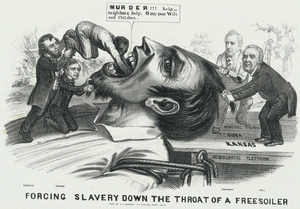
Even as the act was being debated, settlers on both sides of the slavery issue poured into the territories so as to secure the outcome they wanted in the voting. The passage of the act resulted in so much violence between groups that the territory became known as Bleeding Kansas. Thousands of pro-slavery Border Ruffians came across from Missouri to vote in the territorial elections although they were not resident in Kansas, giving that element the victory. Pierce supported the outcome despite the irregularities. When Free-Staters set up a shadow government, and drafted the Topeka Constitution, Pierce called their work an act of rebellion. The president continued to recognize the pro-slavery legislature, which was dominated by Democrats, even after a Congressional investigative committee found its election to have been illegitimate. He dispatched federal troops to break up a meeting of the Topeka government.[33][34]
Passage of the act coincided with the seizure of escaped slave Anthony Burns in Boston. Northerners rallied in support of Burns, but Pierce was determined to follow the Fugitive Slave Act to the letter, and dispatched federal troops to enforce Burns's return to his Virginia owner despite furious crowds.[35][36]
The midterm congressional elections of 1854 and 1855 were devastating to the Democrats (as well as to the Whig Party, which was on its last legs). The Democrats lost almost every state outside the South. The administration's opponents in the North worked together to return opposition members to Congress, though only a few northern Whigs gained election. In Pierce's New Hampshire, hitherto loyal to the Democratic Party, the Know-Nothings elected the governor, all three representatives, dominated the legislature, and returned John P. Hale to the Senate. Anti-immigrant fervor brought the Know-Nothings their highest numbers to that point, and some northerners were elected under the auspices of the new Republican Party.[31][32]
انتخابات 1856
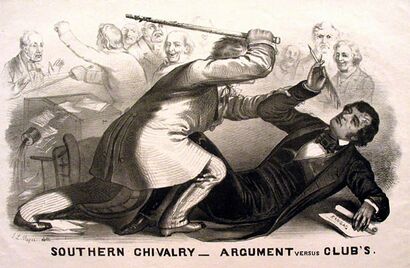
Pierce fully expected to be renominated by the Democrats. In reality, his chances of winning the nomination (let alone the general election) were slim. The administration was widely disliked in the North for its position on the Kansas–Nebraska Act, and Democratic leaders were aware of Pierce's electoral vulnerability. Nevertheless, his supporters began to plan for an alliance with Douglas to deny James Buchanan the nomination. Buchanan had solid political connections and had been safely overseas through most of Pierce's term, leaving him untainted by the Kansas debacle.[38][39][40]
ذكراه
After his death, Pierce mostly passed from the American consciousness, except as one of a series of presidents whose disastrous tenures led to civil war.[41] Pierce's presidency is widely regarded as a failure; he is often described as one of the worst presidents in American history.[note 3] The public placed him third-to-last among his peers in C-SPAN surveys (2000 and 2009).[46] Part of his failure was in allowing a divided Congress to take the initiative, most disastrously with the Kansas–Nebraska Act. Although he did not lead that fight—Senator Douglas did—Pierce paid the cost in damage to his reputation.[47] The failure of Pierce, as president, to secure sectional conciliation helped bring an end to the dominance of the Democratic Party that had started with Jackson, and led to a period of over seventy years when the Republicans mostly controlled national politics.[48]
انظر أيضاً
- List of deaths through alcohol
- New Hampshire Historical Marker No. 80: Franklin Pierce 1804–1869
ملاحظات
- ^ نائب الرئيس كنگ توفي في منصبه. ولما كان ذلك قبل اعتماد التعديل الخامس والعشرين في 1967، شغور منصب نائب الرئيس لم يُملأ حتى الانتخابات التالية والتنصيب.
- ^ Some local accounts suggest he was born in the Homestead. The National Register of Historic Places cites the log cabin as the more likely birthplace,[3] and historian Peter A. Wallner asserts this is conclusively so.[4]
- ^ Wallner writes: "It is doubtful if any former president was as reviled in later life as Franklin Pierce was, and his reputation has hardly improved in the century and a half since his death. If anything, he has been forgotten and relegated to a footnote in history books—as an amiable nonentity who had no business being president and who reached that lofty position purely by the accident of circumstance."[42][43][44][45]
الهامش
- ^ Jeffrey W. Coker (2002). Presidents from Taylor Through Grant, 1849–1877: Debating the Issues in Pro and Con Primary Documents. Greenwood. p. 54. ISBN 978-0-313-31551-0.
Attractive, polished, and outgoing, he was remembered by classmates more for his social skills than his scholarship... he married Jane Means Appleton, the daughter of Bowdoin College's president... Jane was a frail, somewhat sickly, and erratic woman who suffered from bouts of tuberculosis and deep depression... the two enjoyed a successful, if at time difficult, marriage.
- ^ "Pierce, Franklin, Homestead". National Park Service. Archived from the original on March 9, 2015. Retrieved June 29, 2014.
- ^ [[[:قالب:NHLS url]] "Nomination Form: Franklin Pierce"]. National Register of Historic Places. 1976. p. 8. Retrieved June 29, 2014.
{{cite web}}: Check|url=value (help) - ^ Wallner 2004, p. 3
- ^ Wallner 2007, pp. 32–36
- ^ Wallner 2007, pp. 40–41, 52
- ^ Wallner 2007, pp. 25–32
- ^ Gara 1991, p. 128
- ^ Wallner 2007, pp. 61–63
- ^ Gara 1991, pp. 128–129
- ^ Wallner 2007, pp. 75–81
- ^ أ ب Gara 1991, pp. 129–133
- ^ Wallner 2007, pp. 106–108
- ^ Holt 2010, 872
- ^ Wallner 2007, pp. 27–30, 63–66, 125–126
- ^ Gara 1991, p. 133
- ^ Wallner 2007, pp. 26–27
- ^ Gara 1991, pp. 139–140
- ^ Holt 2010, 902–917
- ^ Wallner 2007, pp. 131–157
- ^ Gara 1991, pp. 149–155
- ^ Wallner 2007, pp. 40–43
- ^ Wallner 2007, p. 172
- ^ Gara 1991, pp. 134–135
- ^ Wallner 2007, p. 256
- ^ أ ب ت Wallner 2007, pp. 90–102, 119–122
- ^ أ ب ت Gara 1991, pp. 88–100
- ^ أ ب ت Holt 2010, 1097–1240
- ^ Davis, Jefferson (1881). The Rise and Fall of the Confederate Government. p. 25. ISBN 978-0-306-80418-2.
- ^ Etchison 2004, p. 14
- ^ أ ب Wallner 2007, pp. 158–167
- ^ أ ب Gara 1991, pp. 99–100
- ^ Wallner 2007, pp. 195–209
- ^ Gara 1991, pp. 111–120
- ^ Wallner 2007, pp. 122–125
- ^ Gara 1991, pp. 107–109
- ^ Gara 1991, pp. 120–121
- ^ Wallner 2007, pp. 266–270
- ^ Gara 1991, pp. 157–167
- ^ Holt 2010, 1515–1558
- ^ Gara 1991, p. 180
- ^ Wallner 2007, pp. 377–379
- ^ Wallner 2007, pp. xi–xii: "History has accorded to the Pierce administration a share of the blame for policies that incited the slavery issue, hastened the collapse of the second party system, and brought on the Civil War. ... It is both an inaccurate and unfair judgment. Pierce was always a nationalist attempting to find a middle ground to keep the Union together. ... The alternative to attempting to steer a moderate course was the breakup of the Union, the Civil War and the deaths of more than six hundred thousand Americans. Pierce should not be blamed for attempting throughout his political career to avoid this fate."
- ^ Gara 1991, pp. 180–184: "Those who play the presidential ratings game have always assigned to Franklin Pierce a below-average score. ... In light of subsequent events, the Pierce administration can be seen only as a disaster for the nation. Its failure was as much a failure of the system as a failure of Pierce himself, whom Roy Franklin Nichols has skillfully portrayed as a complex and tragic figure."
- ^ U.S. News & World Report, "Worst Presidents: Franklin Pierce" Archived أكتوبر 2, 2013 at the Wayback Machine (2007): "His fervor for expanding the borders helped set the stage for the Civil War."
- ^ "C-SPAN Survey". C-SPAN. 2009. Archived from the original on July 22, 2014. Retrieved June 30, 2014.
- ^ Gara 1991, p. 182
- ^ Crockett, David A. (December 2012). "The Historical Presidency: The Perils of Restoration Politics: Nineteenth-Century Antecedents". Presidential Studies Quarterly. 42 (4): 881–902. doi:10.1111/j.1741-5705.2012.04023.x.
. . . . . . . . . . . . . . . . . . . . . . . . . . . . . . . . . . . . . . . . . . . . . . . . . . . . . . . . . . . . . . . . . . . . . . . . . . . . . . . . . . . . . . . . . . . . . . . . . . . . . . . . . . . . . . . . . . . . . . . . . . . . . . . . . . . . . . . . . . . . . . . . . . . . . . . . . . . . . . . . . . . . . . . .
المراجع
- Allen, Felicity. Jefferson Davis, Unconquerable Heart. St. Louis, Missouri: University of Missouri Press. 1999. ISBN 0-8262-1219-0.
- Boulard, Garry, "The Expatriation of Franklin Pierce--The Story of a President and the Civil War." (iUniverse, 2006)
- Brinkley, A. and Dyer, D. The American Presidency. 2004. Houghton Mifflin Company.
- DiConsiglio, John. Franklin Pierce. Vol. 14. New York: Children's Press-Scholastic, 2004. ISBN 0-516-24235-0
- Gara, Larry, The Presidency of Franklin Pierce (1991), standard history of his administration
- Nichols; Roy Franklin. Franklin Pierce, Young Hickory of the Granite Hills (1931), standard biography
- Nichols; Roy Franklin.The Democratic Machine, 1850-1854. Columbia University Press, 1923. online version
- Potter, David M, The Impending Crisis, 1848 - 1861. New York, New York: Harper & Row, 1976. ISBN 0-06-013403-8.
- Taylor; Michael J.C. "Governing the Devil in Hell: 'Bleeding Kansas' and the Destruction of the Franklin Pierce Presidency (1854-1856)" White House Studies, Vol. 1, 2001, pp 185-205
وصلات خارجية
- أعمال من Franklin Pierce في مشروع گوتنبرگ
- Franklin Pierce: A Resource Guide from the Library of Congress
- White House biography
- Pierce 200 site
- Inaugural Address
- The Life of Franklin Pierce By Nathaniel Hawthorne
- Pierce Manse
- State of the Union: 1853, 1854, 1855, 1856
- Franklin Pierce and His Services in the Valley of Mexico
- The Health and Medical History of President: Franklin Pierce
- Essays on Pierce and each member of his cabinet and First Lady
- CS1 errors: URL
- Short description is different from Wikidata
- Articles with hatnote templates targeting a nonexistent page
- Pages using multiple image with auto scaled images
- فرانكلين پيرس
- مواليد 1804
- وفيات 1869
- رؤساء الولايات المتحدة
- 19th-century American Episcopalians
- رؤساء الولايات المتحدة في القرن 19
- Alcohol-related deaths in New Hampshire
- American military personnel of the Mexican–American War
- Bowdoin College alumni
- Deaths from cirrhosis
- مرشحون رئاسيون للحزب الديمقراطي الأمريكي
- أمريكان من أصل إنجليزي
- تاريخ الولايات المتحدة(1849–1865)
- أعضاء نادي الأزتك سنة 1847
- Members of the United States House of Representatives from New Hampshire
- New Hampshire Democrats
- Phillips Exeter Academy alumni
- United States Army generals
- مرشحو الرئاسة الأمريكية 1852
- مرشحو الرئاسة الأمريكية 1856
- Speakers of the New Hampshire House of Representatives
- Democratic Party members of the New Hampshire House of Representatives
- United States Attorneys for the District of New Hampshire
- American lawyers admitted to the practice of law by reading law

